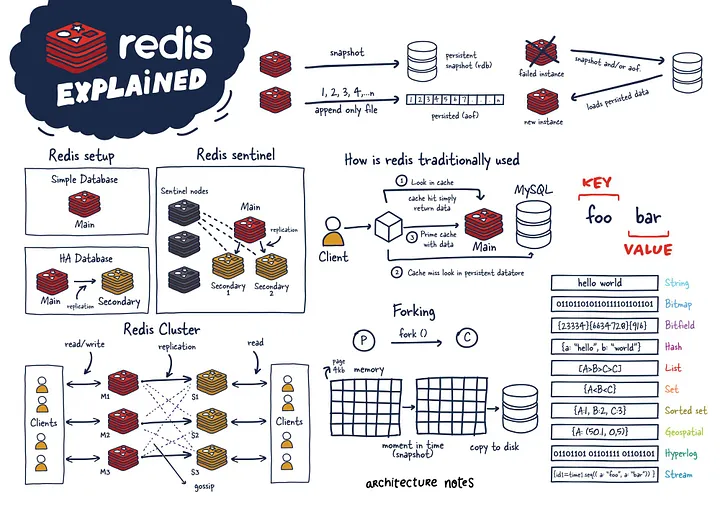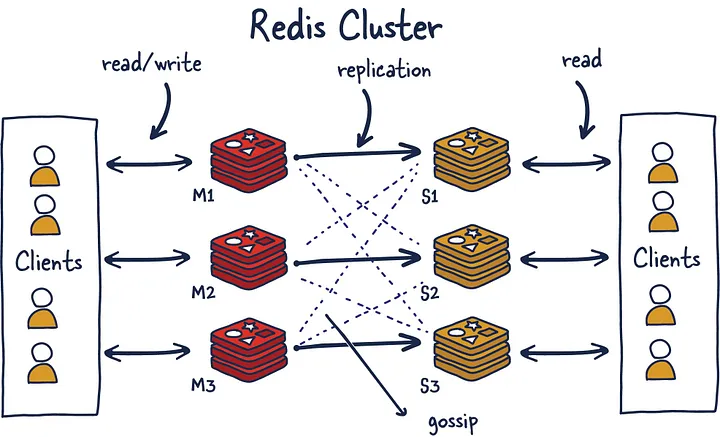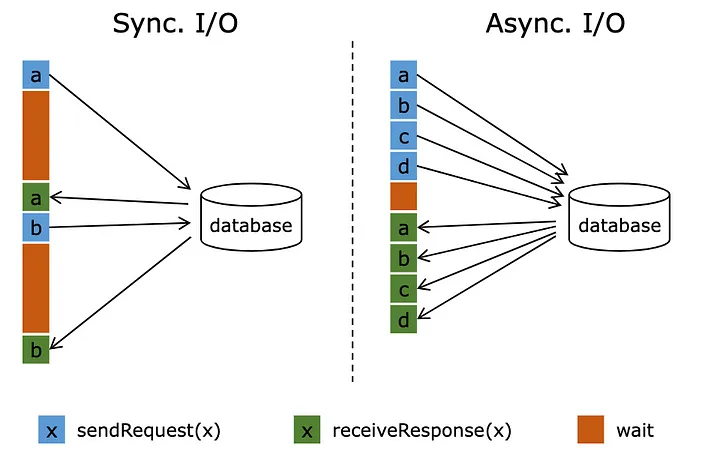Redis 是一種功能強大的 NoSQL 內存數據結構存儲,已成為開發人員的首選工具。雖然它通常被認為只是一個緩存,但 Redis 遠不止于此。它可以作為數據庫、消息代理和緩存三者合一。
Apache Flink和 Redis 是兩個強大的工具,可以一起使用來構建可以處理大量數據的實時數據處理管道。Flink 為處理數據流提供了一個高度可擴展和容錯的平臺,而 Redis 提供了一個高性能的內存數據庫,可用于存儲和查詢數據。在本文中,將探討如何使用 Flink 來使用異步函數調用 Redis,并展示如何使用它以非阻塞方式將數據推送到 Redis。
Redis的故事

“Redis:不僅僅是一個緩存
Redis 是一種功能強大的 NoSQL 內存數據結構存儲,已成為開發人員的首選工具。雖然它通常被認為只是一個緩存,但 Redis 遠不止于此。它可以作為數據庫、消息代理和緩存三者合一。
Redis 的優勢之一是它的多功能性。它支持各種數據類型,包括字符串、列表、集合、有序集合、哈希、流、HyperLogLogs 和位圖。Redis 還提供地理空間索引和半徑查詢,使其成為基于位置的應用程序的寶貴工具。
Redis 的功能超出了它的數據模型。它具有內置的復制、Lua 腳本和事務,并且可以使用 Redis Cluster 自動分區數據。此外,Redis 通過 Redis Sentinel 提供高可用性。
注意:在本文中,將更多地關注Redis集群模式

Redis 集群使用帶哈希槽的算法分片來確定哪個分片擁有給定的鍵并簡化添加新實例的過程。同時,它使用 Gossiping 來確定集群的健康狀況,如果主節點沒有響應,可以提升輔助節點以保持集群健康。必須有奇數個主節點和兩個副本才能進行穩健設置,以避免腦裂現象(集群無法決定提升誰并最終做出分裂決定)
為了與 Redis 集群對話,將使用lettuce和 Redis Async Java 客戶端。
Flink 的故事

Apache Flink 是一個開源、統一的流處理和批處理框架,旨在處理實時、高吞吐量和容錯數據處理。它建立在 Apache Gelly 框架之上,旨在支持有界和無界流上的復雜事件處理和有狀態計算,它的快速之處在于其利用內存中性能和異步檢查本地狀態。
故事的主人公

與數據庫的異步交互是流處理應用程序的游戲規則改變者。通過這種方法,單個函數實例可以同時處理多個請求,從而允許并發響應并顯著提高吞吐量。通過將等待時間與其他請求和響應重疊,處理管道變得更加高效。
我們將以電商數據為例,計算24小時滑動窗口中每個品類的銷售額,滑動時間為30秒,下沉到Redis,以便更快地查找下游服務。
充足的數據集
Category, TimeStamp
Electronics,1679832334
Furniture,1679832336
Fashion,1679832378
Food,16798323536
Flink Kafka 消費者類
package Aysnc_kafka_redis;
import AsyncIO.RedisSink;
import akka.japi.tuple.Tuple3;
import deserializer.Ecommdeserialize;
import model.Ecomm;
import org.apache.flink.api.common.eventtime.WatermarkStrategy;
import org.apache.flink.connector.kafka.source.KafkaSource;
import org.apache.flink.connector.kafka.source.enumerator.initializer.OffsetsInitializer;
import org.apache.flink.streaming.api.datastream.AsyncDataStream;
import org.apache.flink.streaming.api.datastream.DataStream;
import org.apache.flink.streaming.api.datastream.SingleOutputStreamOperator;
import org.apache.flink.streaming.api.environment.StreamExecutionEnvironment;
import org.apache.flink.streaming.api.functions.timestamps.BoundedOutOfOrdernessTimestampExtractor;
import org.apache.flink.streaming.api.functions.windowing.WindowFunction;
import org.apache.flink.streaming.api.windowing.assigners.TumblingEventTimeWindows;
import org.apache.flink.streaming.api.windowing.time.Time;
import org.apache.flink.streaming.api.windowing.windows.TimeWindow;
import org.apache.flink.util.Collector;
import java.util.concurrent.TimeUnit;
public class FlinkAsyncRedis {
public static void main(String[] args) throws Exception {
final StreamExecutionEnvironment env = StreamExecutionEnvironment.getExecutionEnvironment();
Ecommdeserialize jsonde = new Ecommdeserialize();
KafkaSource<Ecomm> source = KafkaSource.<Ecomm>builder()
.setTopics("{dummytopic}")
.setBootstrapServers("{dummybootstrap}")
.setGroupId("test_flink")
.setStartingOffsets(OffsetsInitializer.earliest())
.setValueOnlyDeserializer(jsonde)
.build();
DataStream<Ecomm> orderData = env.fromSource(source, WatermarkStrategy.noWatermarks(), "Kafka Source");
orderData.assignTimestampsAndWatermarks(new BoundedOutOfOrdernessTimestampExtractor<Ecomm>(Time.seconds(10)) {
@Override
public long extractTimestamp(Ecomm element) {
return element.getEventTimestamp(); // extract watermark column from stream
}
});
SingleOutputStreamOperator<Tuple3<String, Long, Long>> aggregatedData = orderData.keyBy(Ecomm::getCategory)
.window(SlidingEventTimeWindows.of(Time.hours(24),Time.seconds(30)))
.apply((WindowFunction<Ecomm, Tuple3<String, Long, Long>, String, TimeWindow>) (key, window, input, out) -> {
long count = 0;
for (Ecomm event : input) {
count++; // increment the count for each event in the window
}
out.collect(new Tuple3<>(key, window.getEnd(), count)); // output the category, window end time, and count
});
// calling async I/0 operator to sink data to redis in UnOrdered way
SingleOutputStreamOperator<String> sinkResults = AsyncDataStream.unorderedWait(aggregatedData,new RedisSink(
"{redisClusterUrl}"),
1000, // the timeout defines how long an asynchronous operation take before it is finally considered failed
TimeUnit.MILLISECONDS,
100); //capacity This parameter defines how many asynchronous requests may be in progress at the same time.
sinkResults.print(); // print out the redis set response stored in the future for every key
env.execute("RedisAsyncSink"); // you will be able to see your job running on cluster by this name
}
}
Redis 設置鍵異步 I/0 運算符
package AsyncIO;
import akka.japi.tuple.Tuple3;
import io.lettuce.core.RedisFuture;
import io.lettuce.core.cluster.RedisClusterClient;
import io.lettuce.core.cluster.api.StatefulRedisClusterConnection;
import io.lettuce.core.cluster.api.async.RedisAdvancedClusterAsyncCommands;
import lombok.AllArgsConstructor;
import org.apache.flink.api.java.tuple.Tuple2;
import org.apache.flink.configuration.Configuration;
import org.apache.flink.streaming.api.functions.async.ResultFuture;
import org.apache.flink.streaming.api.functions.async.RichAsyncFunction;
import scala.collection.immutable.List;
import java.util.ArrayList;
import java.util.Collections;
@AllArgsConstructor
public class RedisSink extends RichAsyncFunction<Tuple3<String, Long, Long>, String> {
String redisUrl;
public RedisSink(String redisUrl){
this.redisUrl=redisUrl;
}
private transient RedisClusterClient client = null;
private transient StatefulRedisClusterConnection<String, String> clusterConnection = null;
private transient RedisAdvancedClusterAsyncCommands<String, String> asyncCall = null;
// method executes any operator-specific initialization
@Override
public void open(Configuration parameters) {
if (client == null ) {
client = RedisClusterClient.create(redisUrl);
}
if (clusterConnection == null) {
clusterConnection = client.connect();
}
if (asyncCall == null) {
asyncCall = clusterConnection.async();
}
}
// core logic to set key in redis using async connection and return result of the call via ResultFuture
@Override
public void asyncInvoke(Tuple3<String, Long, Long> stream, ResultFuture<String> resultFuture) {
String productKey = stream.t1();
System.out.println("RedisKey:" + productKey); //for logging
String count = stream.t3().toString();
System.out.println("Redisvalue:" + count); //for logging
RedisFuture<String> setResult = asyncCall.set(productKey,count);
setResult.whenComplete((result, throwable) -> {if(throwable!=null){
System.out.println("Callback from redis failed:" + throwable);
resultFuture.complete(new ArrayList<>());
}
else{
resultFuture.complete(new ArrayList(Collections.singleton(result)));
}});
}
// method closes what was opened during initialization to free any resources
// held by the operator (e.g. open network connections, io streams)
@Override
public void close() throws Exception {
client.close();
}
}
用例:
- 數據科學模型可以使用流式傳輸到 Redis 的數據來查找和生成更多在銷售季節經常銷售的類別的產品。
- 它可用于在網頁上展示圖表和數字作為銷售統計數據,以在用戶中產生積極購買的動力。
要點:
- Flink 為處理數據流提供了一個高度可擴展和容錯的平臺,而 Redis 提供了一個高性能的內存數據庫,可用于存儲和查詢數據。
- 異步編程可用于通過允許對外部系統(如 Redis)進行非阻塞調用來提高數據處理管道的性能。
- 兩者的結合可能有助于帶來實時數據決策文化。


































